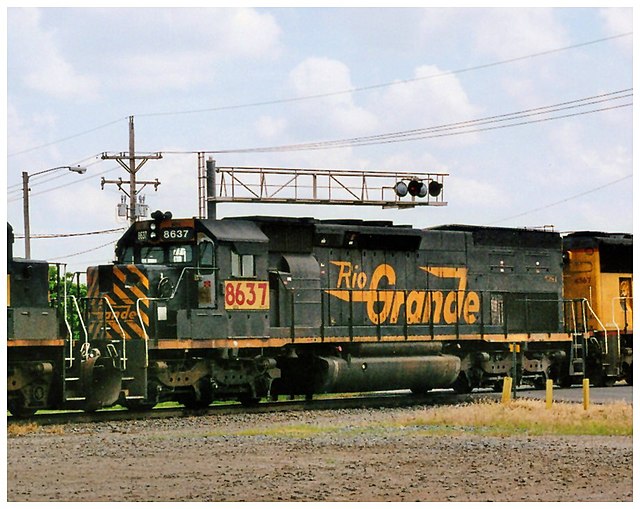Denver and Rio Grande Western No. 168 is a class "T-12" 4-6-0 “Ten Wheeler” type narrow-gauge steam railway locomotive. It is one of twelve similar locomotives built for the Denver and Rio Grande Railroad (D&RG) by the Baldwin Locomotive Works in 1883. It was built as a passenger locomotive, with 46 in (1,200 mm) drivers, the largest drivers used on any three foot gauge D&RGW locomotive. The large drivers made it suitable for relatively fast passenger service.
D&RG No. 168 at the head of a special train taking William Howard Taft to the opening of the Gunnison Tunnel in 1909
D&RG 168 in the Black Canyon of the Gunnison, 1904
Alamosa, 1923
After restoration as seen in 2021 at Antonito
Denver and Rio Grande Western Railroad
The Denver and Rio Grande Western Railroad, often shortened to Rio Grande, D&RG or D&RGW, formerly the Denver & Rio Grande Railroad, was an American Class I railroad company. The railroad started as a 3 ft narrow-gauge line running south from Denver, Colorado, in 1870. It served mainly as a transcontinental bridge line between Denver and Salt Lake City, Utah. The Rio Grande was also a major origin of coal and mineral traffic.
During the late 1800s the D&RG made extensive use of consolidations (engines with a 2-8-0 wheel arrangement). This drawing, of an unusual wheel arrangement, was titled "Standard Consolidation Engine," 1881.
Over the course of decades, D&RG consolidations were subjected to various modifications. In the 20th century, diamond stacks gave way to straight stacks, box headlights were replaced with round ones, decorative trim disappeared from the domes, and wooden pilots (cowcatchers) were replaced with steel ones.
D&RGW 5384, patch-renumbered into UP 8637
D&RGW passenger train at the Colorado Railroad Museum. The F9 A&B diesel electric locomotives (1955) were used for the California Zephyrs and Rio Grande Zephyrs.








